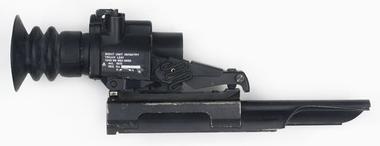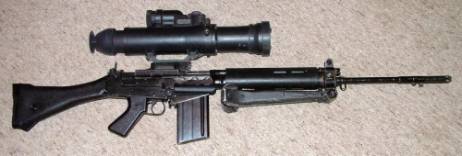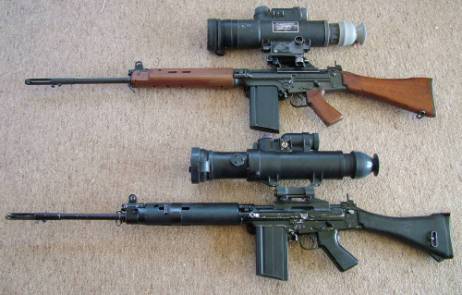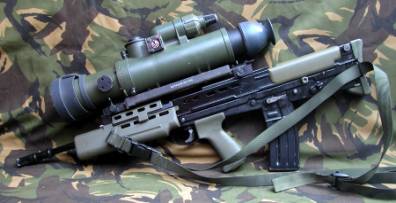SIGHTING EQUIPMENT
L2A1 Sight Unit, Infantry Trilux

When the British Government deployed troops to Northern Ireland in 1969 on internal security duties, it rapidly became
apparent that the fixed iron sights of the L1A1 SLR, would not allow for easy identification of enemy combatents in an
urban environment. In 1973, in an attempt to reduce civilian casualties the L2A1 "Sight Unit, Infantry, Trilux" (SUIT)
was introduced into service.
The L2A1 SUIT, was attached to the modified receiver cover. The SUIT featured a fixed-focus
scope of four-times magnification setting, with an eight degree field of view. The SUIT also featured a prismatic offset
and inverted tapered sight, the prismatic offset design reduced the length of the site and improved clearance around the
action. The SUIT helped to reduce parallax errors and heat mirage from the barrel, if it were to get hot during
firing. The inverted sight post allowed rapid target re-acquisition after the recoil of the firearm raised the rifle
barrel. Despite the SUITs weight, the scope was durable and robust. During the Cold War, the British "SUIT" scope was copied
by the Soviet Union and designated the 1P29 telescopic sight.
L1A1 SLR with L2A1 SUIT

In 1968 the Signals Research and Development Establishment (SRDE) Christchurch unveiled a generation one image
intensifier weapon sight they had developed. The range stated was 400 metres under “average light conditions”.
Within two years the British Army had its new Individual Weapon Sight (IWS) officially designated as “Weapon-sight,
Image Intensified”, LIAI.
L1A1 SLR with "Weapon-sight, Image Intensified”, L1A1 & Bipod

The L1A1 IWS was quite versatile and could be fitted on the L1A1 SLR, AR15, L7A1 GPMG, Carl Gustav and L42A1 Sniper Rifle.
Under clear starlight conditions it had a range of up to 300 metres, which increased as light levels increased. The sight
provided a magnification of 3.75 and a field of view of about 10 degrees. The intensifier was powered by a 6.75 volt
battery, which had a service life of about 70 hours. With batteries it weighed. 2.9 kg. There was also a US version in
service although very similar in appearance and function; there were some differences. The power switch worked in the
opposite direction, the means of focussing the object lens and eyepiece differed. The US version had X 4 magnification,
was 25mm shorter, and weighed 3 kg.
Below: L1A1 SLR with US version IWS

Above: Australian L1A1 SLR with UK version IWS
In 1987 a more compact sight was introduced, known as Weapon-sight, Image Intensified, L6A1. This used a generation
two image intensifier and was designed primarily, to be mounted directly onto the Rifle, 5.56mm, L85A1, but most were
fitted to the L42A1. The sight could also be used in daylight in an emergency, for training or for zeroing purposes,
provided a special filter was fitted to protect the sensitive converter tube from serious damage. It was intended that
the sight could be operated in full NBC kit including Respirators S6 and S10, and it was compatible with military
spectacles. Under clear starlight conditions it had a range of up to 300 metres, which increased as light levels increased.
The sight provided a magnification of X 2.5 and a field of view of about 15 degrees.
This made it more suitable for surveillance and could be used as a hand-held device for observation. The intensifier was
powered by two AA-size 1.5 volt batteries, which had a service life of about 50 hours. With batteries it weighed 1.3 kg.
L85A2 with L6A1
